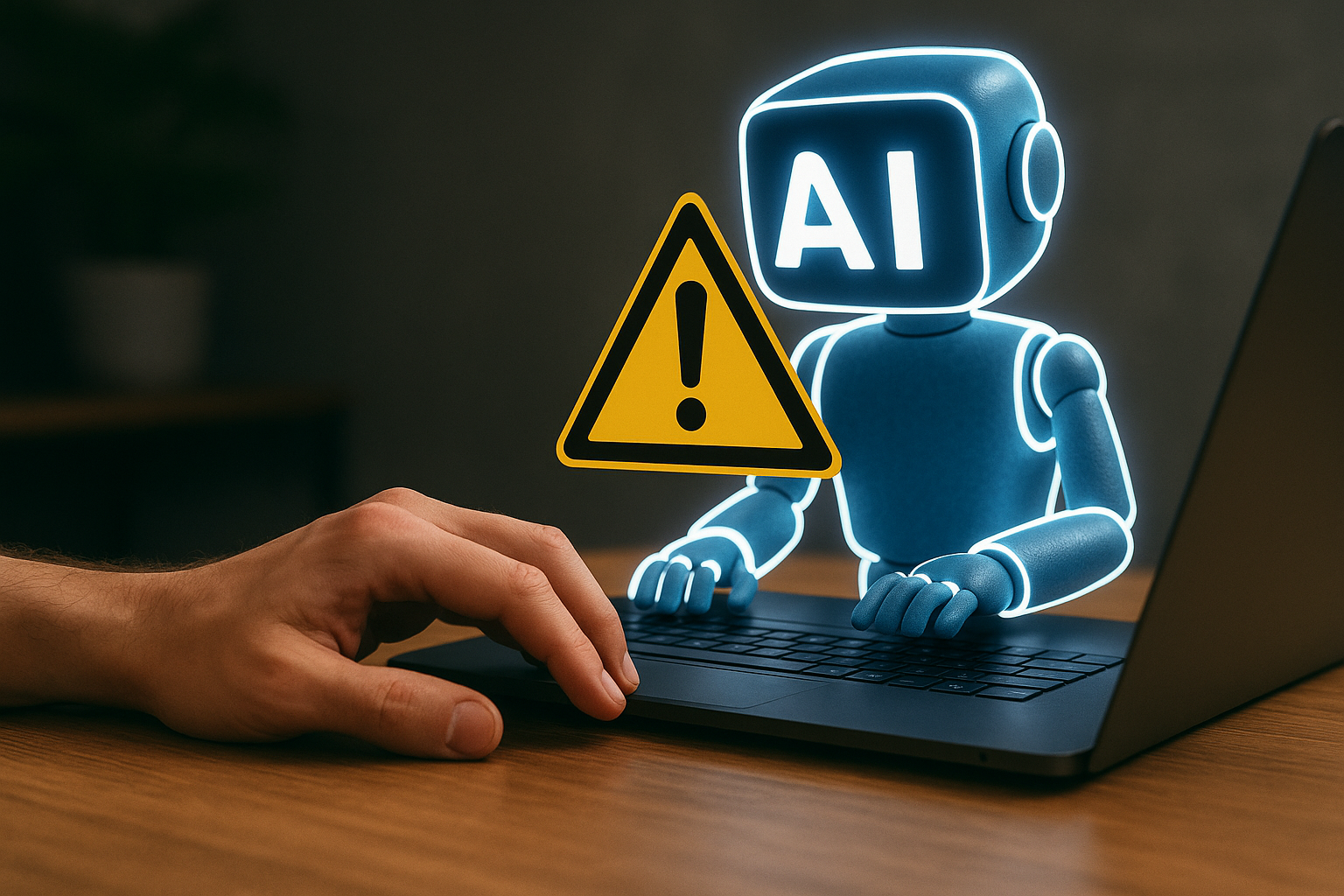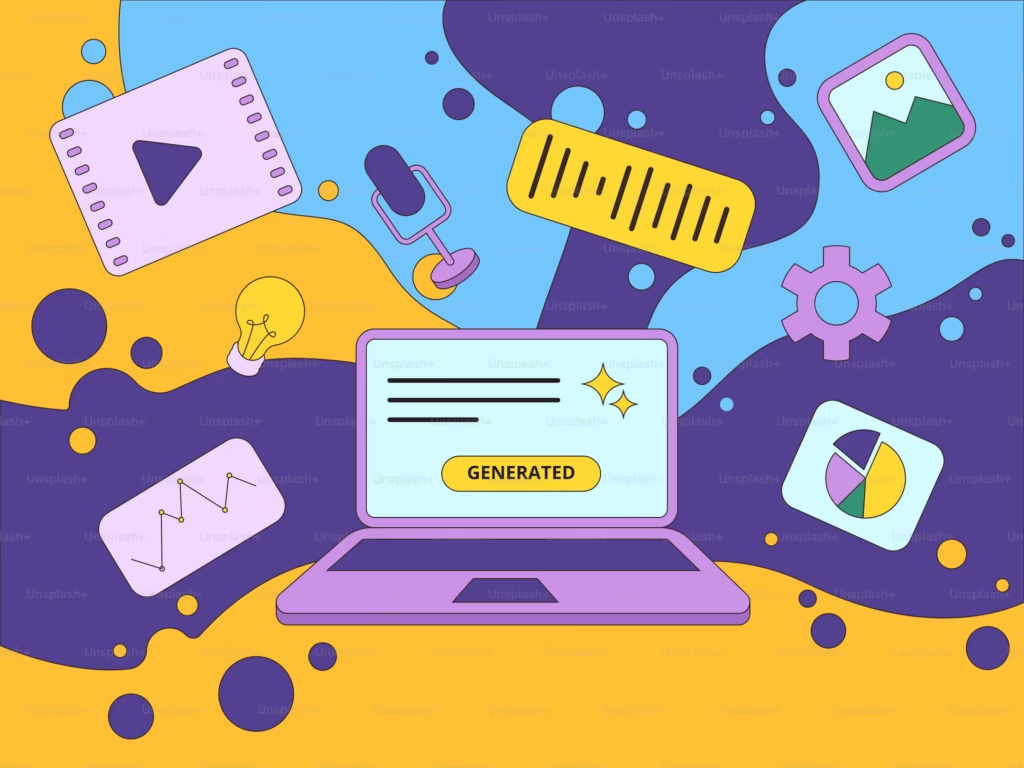Physical Address
304 North Cardinal St.
Dorchester Center, MA 02124
Physical Address
304 North Cardinal St.
Dorchester Center, MA 02124

AI for content creation is becoming more popular every day. Many businesses and bloggers use tools like ChatGPT or Jasper to write blog posts, social media captions, and even emails. These tools are fast, easy to use, and can create a lot of content in a short time.
But is faster always better? While AI tools can help save time and effort, relying on them too much can lead to problems. The risks of AI-generated content are often hidden at first. For example, the writing may sound robotic or lack a personal touch. Some AI-generated texts may also have incorrect facts or repeat the same ideas.
There are also content automation concerns. Google prefers original, human-written content. If your website has too much AI content, it might hurt your SEO ranking. This means fewer people will find your content on search engines.
Another issue is brand voice. AI may not fully understand your business tone or values. Over time, this can confuse your readers or weaken your brand trust.
In this blog, we’ll explore the hidden dangers of overusing AI for content. You’ll learn how to avoid common mistakes and how to use AI the smart way—without losing your unique voice.

Using AI for content creation has become very popular, and it’s easy to see why. One big reason is speed. AI tools can write blogs, product descriptions, and social media posts in just a few seconds. This makes it easier to keep up with fast-moving digital trends.
Another benefit is efficiency. You can create a lot of content without spending too much time or energy. Compared to hiring a team of writers, AI tools are also cost-effective. Businesses can save money while still producing high volumes of content.
Scalability is also a major plus. As your content needs grow, you can use AI to keep up without adding more people. This makes AI a helpful partner for growing brands.
AI tools are available 24/7. Whether it’s late at night or during a weekend, you can generate new ideas or even full drafts anytime. This nonstop access is a huge advantage for content teams.
While these benefits are clear, it’s important to remember that there are still content automation concerns and AI-generated content risks. Relying only on AI might not always be the best choice, especially when comparing human vs AI content.
AI writing tools can be helpful, but they’re not perfect. If you rely too much on them, you might face serious problems. Let’s explore the main AI-generated content risks and why you should be careful when using AI for content creation.
One of the biggest problems with using AI too often is that it can make your content sound the same as everyone else’s. Most AI tools pull ideas from the same sources, so their outputs can feel generic and robotic. This becomes a major issue in the ongoing Human vs AI content debate.
AI does not truly understand your brand’s voice or unique tone. It cannot show the emotion, personal touch, or creativity that a human writer can. Over time, this can lead to a dilution of your brand identity. Your content may no longer feel original or connected to your audience.
Also, AI tools often repeat phrases or structures. You may notice similar sentence patterns like “In today’s world…” or “It is important to note that…” popping up again and again. This kind of repetition is a clear sign of content automation concerns. It makes your blog posts or social media captions less engaging.
To keep your content fresh and on-brand, it’s important to include a human touch. AI can help you get started, but it should not be the only voice your readers hear.
One serious risk of using AI writing tools is the chance of spreading false information. AI does not actually “know” facts—it generates content based on patterns in the data it was trained on. This leads to a common issue known as AI hallucinations. That means the tool may write something that sounds correct but is actually completely wrong.
For example, an AI might invent statistics, quote fake studies, or reference people who don’t exist. If you publish this kind of information, it can harm your brand’s reputation. Even worse, it could create legal and ethical problems, especially if your business is in a regulated industry like health or finance.
Another issue is that AI tools often don’t have real-time awareness. They may not include the latest news or trends because they work with older data. So if you’re writing about current events, relying on AI can lead to outdated content.
These problems highlight why blind trust in AI tools is dangerous. AI-generated content risks are real, and everything they produce should be reviewed carefully before publishing.
Many people use AI writing tools to improve their SEO. It’s fast and easy to create keyword-rich articles with AI. But if you’re not careful, you might end up hurting your site’s rankings instead of helping them.
Google has made it clear that AI-generated content will be judged by the same quality standards as human content. Their E-E-A-T guidelines focus on Experience, Expertise, Authoritativeness, and Trustworthiness. If your AI-written content lacks depth or provides false information, Google may not rank it well.
Duplicate content is another big concern. If multiple websites use AI to write about the same topic, their content can start looking almost identical. This is one of the major content automation concerns. Search engines may penalize pages that seem copied or offer no unique value.
AI tools can also create problems with keyword stuffing—adding too many keywords unnaturally in an attempt to rank higher. While it may work in the short term, this tactic can damage your SEO in the long run.
To avoid these AI-generated content risks, always edit and improve AI content before publishing. Make sure it’s useful, trustworthy, and different from what’s already online.
Another hidden danger of relying too much on AI is the decline of human creativity. When writers become dependent on AI tools for ideas, outlines, and even full drafts, they may stop thinking critically. Over time, this weakens their writing skills and original thinking.
Creativity is what makes human content special. When comparing Human vs AI content, you’ll notice that AI struggles with emotion, humor, and storytelling. These are elements that truly connect with people and keep them interested. AI-generated content often lacks these deeper qualities.
Also, AI doesn’t understand context the way people do. It cannot sense irony, sarcasm, or cultural sensitivity. This can lead to awkward phrasing or even offensive statements.
When you overuse AI, your content quality can start to decline. This is one of the more subtle AI-generated content risks, but it has long-term effects. Audiences may lose interest if your content starts to feel lifeless or generic.
Instead of letting AI do all the work, use it as a starting point. Add your voice, personality, and insights to create content that truly stands out.
Who owns AI-generated content? This question doesn’t always have a clear answer. Many AI tools use public data to generate text, but they don’t create truly original content. This leads to confusion over copyright and ownership rights.
If your AI-generated article includes phrases that are too similar to something already published, you could face plagiarism issues. Even if it’s unintentional, this can lead to legal trouble or damage your brand’s reputation.
Some platforms even block or ban users who try to upload purely AI-generated content without disclosure. This is another reason why blindly trusting AI can backfire.
In some countries, AI-generated works may not be protected by copyright laws. That means someone else could copy your AI-written blog post—and you might not be able to do anything about it.
These are serious content automation concerns that all marketers and writers should think about. If you want to protect your content and reputation, it’s smart to involve humans in the editing and review process.
Trusting AI tools too much can cause serious problems. Here’s why:
To avoid these AI-generated content risks, always review and refine AI outputs. In the Human vs AI content conversation, remember machines assist, but humans connect.

AI tools are great for speeding up work, but they should not replace human creativity. To avoid common content automation concerns, it’s important to find the right balance.
Use AI for content creation as a helpful partner. Let it assist with ideas, outlines, and drafts. But always keep a human in control of the final version. This way, your content stays accurate, personal, and engaging.
A great read on this topic is “How to Balance AI and Human Creativity in Content Marketing”. It explains how to make AI and human input work together effectively.
Human editing is a must. AI may miss the right tone, include outdated facts, or repeat phrases. A human can fix these issues and make sure the content feels real and on-brand. Also, always check for facts. One of the biggest AI-generated content risks is sharing wrong or misleading information. Human fact-checking protects your credibility.
In the Human vs AI content conversation, the best solution is not choosing one over the other. Instead, use a hybrid content strategy. Combine the speed of AI with the creativity and insight of people. When you use AI as a collaborator—not a replacement—you get the best results. You save time while keeping your unique voice and building stronger connections with your audience.
AI is a powerful tool in today’s digital world. It helps with speed, content ideas, and saving time. But even the best tools have limits. When it comes to AI for content creation, it should support—not replace—human creativity.
Overusing automation can lead to problems. These include loss of brand voice, factual errors, and poor engagement. These are serious AI-generated content risks that no brand should ignore. That’s why it’s important to stay aware of content automation concerns.
Your content should reflect your values and connect with your audience. Only a human can bring emotion, experience, and personal stories. In the Human vs AI content debate, the best choice is a mix of both.
Use AI as a smart assistant, not the main creator. Stay involved in every step—review, edit, and refine. This ensures quality and builds trust with your readers. Remember, the goal is to use AI with purpose—not depend on it blindly. Stay strategic, stay creative, and always keep your brand’s voice at the center.
Q1: What is the difference between human and AI content?
Human content is created by people using their creativity, emotions, and experiences. AI content is generated by machines using algorithms and data patterns. While AI can produce content quickly, human content tends to be more original and relatable.
Q2: What are the main risks of AI-generated content?
There are several AI-generated content risks to watch out for. These include loss of originality, spreading misinformation, poor tone, repetitive phrasing, and potential SEO penalties. Overreliance on AI may also reduce human creativity and critical thinking.
Q3: Can AI replace human writers?
AI tools are great for speeding up writing tasks and helping with ideas. But AI should not replace human creativity. The best approach is a hybrid strategy where AI assists writers but humans guide the final tone, accuracy, and storytelling.
Q4: How can I manage content automation concerns?
To avoid common content automation concerns, always review and edit AI-generated content. Use AI as a collaborator, not a replacement. Fact-check information, personalize your brand voice, and avoid keyword stuffing to keep your content high quality.
Q5: Is AI content good for SEO?
AI content can help with SEO by generating volume and keywords. However, poor-quality or duplicated AI content can harm your rankings. Follow Google’s guidelines and focus on producing useful, original content with human input.
If you want to learn more about balancing AI and human creativity in content, visit icebergaicontent.com.